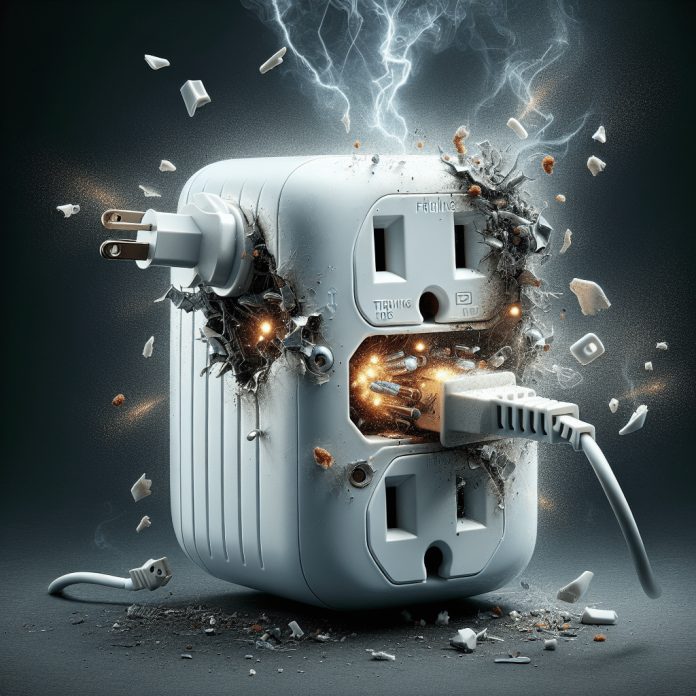In our quest for crispy, delicious fried food without the guilt, many of us have turned to the trusty air fryer. However, there is nothing more frustrating than eagerly preparing a meal, only to have our air fryer trip the breaker and leave us in the dark. But fear not, as we have explored the common culprits behind this electrical nuisance and have rounded up some helpful solutions to keep your air fryer – and your taste buds – happy and functioning flawlessly.
Possible Causes
Overloaded Circuit
One potential cause for an air fryer tripping the breaker is an overloaded circuit. This occurs when the total power demand from various appliances and devices connected to the circuit exceeds its capacity. The air fryer, along with other high-power appliances such as microwaves or refrigerators, can contribute to excessive power consumption and cause the circuit to trip.
Faulty Breaker
Another possible cause is a faulty breaker. Breakers are designed to protect the circuit and prevent it from overloading. However, if the breaker itself is defective or worn out, it may trip unnecessarily, including when the air fryer is in use. A malfunctioning breaker needs to be either reset or replaced to address the tripping issue.
Damaged Power Cord
A damaged power cord could also be to blame for the air fryer tripping the breaker. Over time, power cords can become frayed, pinched, or otherwise damaged. These defects can create short circuits or disruptions in the flow of electricity, which can lead to the breaker tripping as a safety measure.
Dysfunctional Air Fryer
Lastly, the air fryer itself may be dysfunctional and causing the breaker to trip. Internal malfunctions or electrical issues within the appliance can overload the circuit and trigger the breaker to trip. In such cases, troubleshooting the air fryer or seeking repairs from the manufacturer may be necessary.
How to Troubleshoot
Check Power Load
To determine if an overloaded circuit is the cause, we need to assess the power load on the circuit. Start by identifying all the appliances and devices connected to the circuit. Calculate their power usage by referring to their respective labels or manuals. If the total power consumption exceeds the circuit’s capacity, reducing the power load by unplugging or relocating some appliances may solve the issue.
Inspect Breaker
Next, inspecting the breaker is crucial in troubleshooting the problem. Check for any signs of physical damage or loose connections. If everything appears intact, test the breaker’s functionality using a multimeter. Ensure that the breaker is properly reset and firmly seated in its position. If these steps do not resolve the issue, it may be necessary to replace the breaker with a new one.
Examine Power Cord
If the power cord is suspected to be the culprit, a thorough examination is necessary. Inspect the cord for any visible signs of damage, such as frayed or exposed wires. If any issues are found, replacing the power cord is recommended. However, if the damage is minimal, it may be possible to repair the cord by wrapping the affected area with electrical tape or seeking professional assistance.
Test Air Fryer on a Different Outlet
To ascertain whether the air fryer itself is causing the breaker to trip, trying it on a different outlet can be helpful. Plug the air fryer into another circuit or an outlet on a completely separate breaker. If it does not trip the alternate breaker, it indicates that the air fryer is not the problem. However, if it continues to trip the breaker, further troubleshooting or repairs may be required.
Resolving the Issue
Reduce Power Load
If an overloaded circuit is determined to be the cause, reducing the power load is the first step to resolving the issue. Unplugging or relocating certain appliances to different circuits or outlets can help distribute the power more evenly. Additionally, limiting the use of high-power appliances simultaneously can prevent the circuit from tripping.
Reset or Replace Breaker
In the case of a faulty breaker, resetting it is the initial action to take. Turning the breaker off and then back on can help reset its internal mechanism. If the breaker continues to trip, even after resetting, replacing the breaker with a new one may be necessary. It is important to ensure the new breaker matches the electrical specifications and is properly installed by a qualified professional.
Repair or Replace Power Cord
Once a damaged power cord is identified, the best course of action may be to repair or replace it. If the damage is minimal, repairing the cord by wrapping it with electrical tape can be a temporary solution. However, for extensive damage or if safety is a concern, replacing the power cord is recommended. It is essential to use a cord that meets the air fryer’s requirements and follow the manufacturer’s guidelines.
Repair or Replace Air Fryer
In the event that the air fryer itself is found to be dysfunctional, seeking repairs or considering a replacement may be necessary. If the appliance is still under warranty, contacting the manufacturer for repairs is advisable. They may offer assistance or recommend authorized service centers. If the warranty has expired, it may be worth considering purchasing a new air fryer, taking into account the cost comparison between repairs and a replacement.
Overloaded Circuit
Understanding Circuit Capacity
A circuit’s capacity refers to the maximum amount of electrical current it can safely handle. It is measured in amps (A) and is determined by the wire gauge and the breaker protecting the circuit. Understanding the circuit’s capacity is crucial in identifying and addressing an overloaded circuit issue.
Calculating Appliance Power Usage
To calculate the power usage of an appliance, refer to the wattage stated on the appliance label or in the user manual. If the wattage is not directly provided, multiply the current in amps (A) by the voltage (V) as stated on the label or standard voltage for your region (usually 120V in North America). The result is the power consumption of the appliance in watts (W).
Distributing Power Load
Distributing the power load among multiple circuits can prevent overloading. By identifying the appliances with higher power usage and spreading them across different circuits, the overall demand on any specific circuit can be reduced.
Using a Dedicated Circuit
For appliances that require a significant amount of power, it is often recommended to use a dedicated circuit. A dedicated circuit means that the appliance is the only device connected to that specific circuit. This ensures that no other appliances can contribute to an overload that may trip the breaker.
Faulty Breaker
Testing Breaker Functionality
To test the functionality of a breaker, use a multimeter set to the continuity or resistance mode. With the breaker in the off position, place one probe on each terminal screw of the breaker. If the multimeter displays a reading of zero or very low resistance, the breaker is functioning correctly. However, if there is no continuity or a high resistance reading, it indicates a faulty breaker that needs to be replaced.
Resetting the Breaker
To reset a breaker, switch it to the fully off position and then back on. This action engages the internal mechanism and resets the breaker. It is important to perform a proper reset by firmly pushing the breaker switch to the off position before turning it back on. This ensures a complete reset and disengages any tripped state.
Replacing the Breaker
If the breaker continues to trip even after a reset, it may be necessary to replace the breaker. To replace a breaker, first, turn off the main power supply to the panel. Carefully remove the panel cover and disconnect the wires connected to the faulty breaker. Install the new breaker by connecting the wires and firmly seating it in place. Finally, reinstall the panel cover and restore the power supply.
Damaged Power Cord
Inspecting for Visible Damage
When inspecting the power cord for damage, check for any visible signs such as fraying, cuts, or exposed wires. Damage to the outer sheath of the cord or any abnormalities should be addressed as they pose risks of electric shock or short-circuits.
Replacing the Power Cord
If the power cord shows significant damage or if safety is a concern, it is best to replace the entire cord. To ensure a proper replacement, obtain a cord that matches the electrical requirements of the air fryer and follow the manufacturer’s guidelines for installation.
Repairing the Power Cord
For minor damage, such as a small cut or exposed wire, it may be possible to repair the power cord. Start by disconnecting the cord from the power source. Clean the damaged area and remove any loose strands. Wrap the affected area tightly with electrical tape, ensuring proper insulation and no exposed wires. However, it is important to note that repair methods may vary, and seeking professional assistance is recommended for complex or significant damage.
Dysfunctional Air Fryer
Checking for Malfunctions
To check for malfunctions in the air fryer, start by ensuring that all settings and controls are functioning properly. Verify that the timer, temperature settings, and any other features are operating as intended. Inspect the heating elements for any visible signs of damage or unusual behavior.
Resetting the Air Fryer
Resetting the air fryer to its default settings can sometimes resolve minor malfunctions. Refer to the user manual for specific instructions on how to perform a reset. Usually, it involves pressing a combination of buttons or holding a specific button for a certain duration. After the reset, test the air fryer to see if it continues to trip the breaker.
Contacting Manufacturer for Repairs
If the air fryer remains dysfunctional, it is advisable to contact the manufacturer for further assistance. Check if the appliance is still under warranty as repairs or replacements may be covered. The manufacturer’s customer support team can provide guidance on troubleshooting steps or recommend authorized service centers for repairs.
Check Power Load
Understanding Power Load Capacity
Power load capacity refers to the maximum electrical power that a circuit or electrical wiring can handle without being overloaded. It is essential to understand the power load capacity of a circuit before connecting multiple appliances to it, as exceeding this limit can lead to tripped breakers or electrical hazards.
Calculating Power Usage of Other Appliances
To calculate the power usage of other appliances connected to the circuit, follow the same approach used for calculating the air fryer’s power consumption. Identify the wattage or current rating of each appliance and multiply it by the voltage. Sum up the power usage of all appliances to determine the total power load on the circuit.
Unplugging Other Appliances
If the power load on the circuit is too high, it may be necessary to unplug certain appliances. Start by identifying the appliances with high power requirements and determine if they can be relocated to a different circuit or removed temporarily. Prioritize essential appliances and distribute the power load evenly among the available circuits.
Using a Different Outlet or Circuit
If redistributing the power load is not feasible, using a different outlet or circuit can be a potential solution. Find an outlet or circuit that is not overloaded and connect the air fryer to it. However, it is important to consider the circuit’s capacity before adding additional appliances to ensure it is not overloaded.
Inspect Breaker
Visually Inspecting the Breaker
During the inspection, check for any signs of physical damage, such as burnt marks, discoloration, or loose connections. Carefully examine the terminals, wires, and connections leading into and out of the breaker. Ensure that all wiring is properly secured and that there are no loose or exposed wires that could lead to electrical hazards.
Testing the Breaker with a Multimeter
Using a multimeter in the voltage mode, check for voltage between each terminal screw and the ground wire or grounding bar. The voltage should be within the range of the circuit’s standard voltage. In addition, test for continuity between the terminals of the breaker by switching the multimeter to the continuity or resistance mode. Lack of continuity or a high resistance reading indicates a faulty breaker.
Checking for Loose Connections
Loose connections can cause an inconsistent flow of electricity, leading to tripped breakers. Ensure that all wires are tightly secured to the breaker terminals, and there are no loose or improperly installed screws or nuts. Tightening any loose connections and ensuring proper contact can help eliminate this as a potential cause for the breaker tripping.
Repair or Replace Air Fryer
Checking Warranty Coverage
If the air fryer is still within the warranty period, it is crucial to check if the specific issue causing the breaker to trip is covered. Review the warranty terms and conditions provided by the manufacturer. Contact their customer support or refer to their website for more information on filing warranty claims or requesting repairs.
Contacting Customer Support
Regardless of warranty coverage, contacting the manufacturer’s customer support is recommended when troubleshooting or considering repairs. They can provide specific guidance based on the air fryer model and assist in diagnosing the issue. Customer support may offer suggestions on resolving the problem or direct you to authorized service centers for further assistance.
Replacing the Air Fryer
If the air fryer is beyond repair or the cost of repairs outweighs the value of the appliance, it may be necessary to consider replacing it. In such cases, research the market for a suitable replacement that meets your desired specifications and budget. Take into account factors such as brand reputation, customer reviews, and energy efficiency to make an informed decision.
In conclusion, air fryers tripping the breaker can be caused by various factors such as an overloaded circuit, faulty breaker, damaged power cord, or dysfunctional air fryer itself. By understanding the possible causes and following the troubleshooting steps outlined above, users can effectively resolve the issue and continue enjoying the benefits of air frying without interruptions. Remember to prioritize safety and consult professionals when necessary to ensure proper repairs or replacements.






































